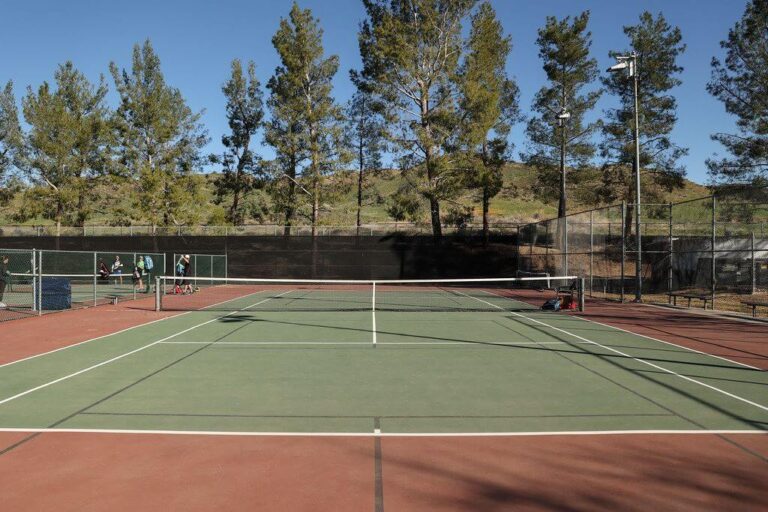
Applying the best pickleball court surface coating will improve your homemade court drastically. It provides better cushioning for your legs, a smoother surface for your pickleball, and other improvements for players in general.
There are tons of benefits to using the best pickleball court material, but with the dozens of options out there, how are you supposed to choose? Which material really is the best pickleball court surface?
We understand your dilemma, so that’s what we’re going to be answering today.
What is a Pickleball Court Surface?
A pickleball court surface is basically the layer of material that covers the base layer of the court and makes the surface playable. These specialized materials are available in different colors and textures. Court surfaces are common in other sports as well, like tennis, basketball, and other court sports.
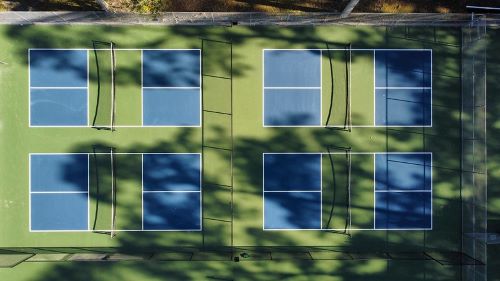
While a pickleball court surface and the base are two different things, some courts don’t use a court surface. Instead, they have a bare concrete or asphalt surface that is sometimes polished. This is not recommended to play on, and we’ll tell you why later.
These hard surfaces are especially not allowed in pickleball tournaments, where the playing surface is subject to strict regulations to ensure that all players have a fair and safe playing experience. The surface must optimize ball bounce and ball response, and be made of a non-glare material like acrylic coating or a polyurethane sport surface.
It should also reduce the risk of injury for players. For this reason, the best surface must be several millimeters thick to reduce the impact on players’ joints and muscles, and must not be too abrasive in case players trip or fall down while playing.
Why is a Pickleball Court Surface Necessary?
A proper pickleball court surface can maximize ball response and minimize the risk of player injury. It should provide the right amount of texture for traction, and enough cushioning and shock absorption in case of slips and falls. This is especially important for older players or those with pre-existing joint conditions.
While the initial cost of installing a specialized surface may be higher than simply using a concrete or asphalt base layer, it is ultimately more cost-effective in the long run. Unlike bare concrete or asphalt, a specialized surface can withstand the wear and tear of regular play. It is also easier to maintain and can last for years without needing major repairs, making it a good long-term investment.
The Kinds of Pickleball Court Surfaces
In this section, we’ll talk about the best and worst kinds of pickleball court surfaces you can buy. Each type of court surface will be broken down into its pros and cons, price, and maintenance for your convenience.
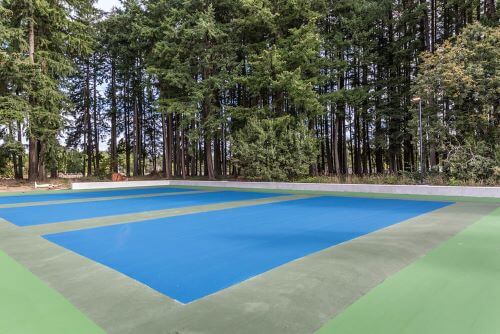
Best Pickleball Court Surfaces You Can Buy:
Let’s start with the best that money can buy. These court surfaces are what professional pickleball courts use.
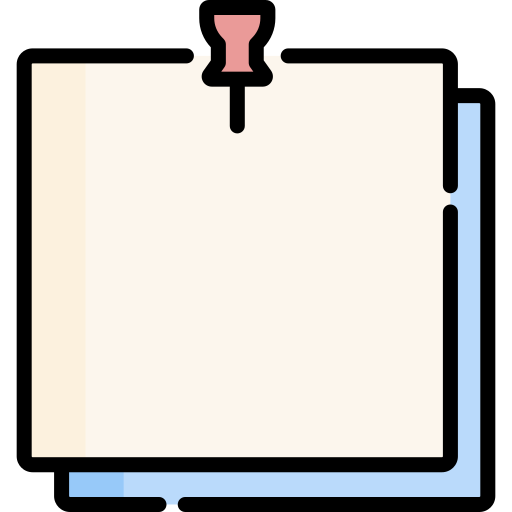
-
Polyurethane
Polyurethane is a popular material for pickleball court surfaces due to its durability and comfortable playing experience. It is typically applied as a coating over an asphalt or concrete base layer to create a smooth, non-slip surface.
This synthetic material combines two components, typically a resin and a hardener. The result is a durable, flexible, and waterproof material known for its consistent ball bounce and low abrasion on players’ skin.
| Pros | Cons |
|---|---|
| Affordable Durable and flexible Resistant to wear and tear |
Durable but needs to be maintained regularly to keep it in good condition |
| Provides good traction and shock absorption for the benefit of players’ joints | If wet, polyurethane can become slippery and unsafe to play on, so it may not be suitable for extremely cold or hot weather conditions—particularly the outdoors |
| Can be pigmented to create a variety of colors and designs to match the aesthetics of any space |

| Price: | Maintenance: |
|---|---|
| The cost of covering a pickleball court surface with polyurethane will vary depending on the size of the court and the quality of materials used. It generally ranges from $0.50-$1.00 per square foot. | To keep a polyurethane court surface in good condition, regular maintenance is required. This includes:
The cost of maintenance will depend on the size of the court and the level of repair needed, but you can expect to spend anywhere from $1,000 every 3 to 5 years. |
-
Acrylotex
Acrylotex is another popular material used for pickleball court surfaces. Like polyurethane, it is a type of acrylic coating made by blending acrylic resins, sand, and other additives for durability and flexibility. The difference is acrylotex has a textured finish that provides good traction for players in order to reduce the risk of slips and falls.
This type of coating can be applied to both indoor and outdoor courts. It is mixed on-site and applied in multiple coats to create a durable surface.
| Pros: | Cons: |
|---|---|
| Good balance of durability, cost, and performance | Not as durable as plexiflor |
| Offers excellent traction and is slip-resistant | Requires professional installation, which can add to the overall cost |
| Resistant to weathering, UV rays, and chemical damage | Does not provide as much cushioning as other materials |
| Can be customized with a variety of colors and graphics | |
| Low maintenance, easy to clean, and does not require frequent resurfacing | |
| Good for both indoor and outdoor use |

| Price: | Maintenance: |
|---|---|
| The cost of Acrylotex varies depending on factors such as court size, location, and installation fees. On average, it can cost anywhere from $1 to $2 per square foot to install. | The maintenance cost is relatively low compared to other court surface materials, with the occasional resurfacing being the primary expense. at $1,200 every 4 to 6 years. Here’s how to maintain an Acrylotex pickleball court surface:
|
-
Plexiflor
Plexiflor is a smoother acrylic coating that is suitable for all weather conditions and is often used in high-traffic areas due to its durability. It is typically applied in multiple layers to create a smooth surface with good traction that is resistant to fading and chalking.
Due to its durability and resistance to fading, it is an ideal choice for both indoor and outdoor courts. Plexiflor is also customizable, allowing for a range of colors and designs.
| Pros: | Cons: |
|---|---|
| Durable and long-lasting Consistent bounce and the most common surface for professional courts Suitable for all weather conditions Customizable with a range of colors and designs |
Expensive and can be difficult to install and repair |

| Price: | Maintenance: |
|---|---|
| The cost of Plexiflor varies depending on factors such as the size of the court, location, and installation costs. On average, it can cost anywhere from $2.00 to $4.00 per square foot. | Sweep or mop the surface regularly to remove dirt and debris. Use a mild soap and water solution to clean the surface more thoroughly. Avoid using harsh chemicals or abrasive cleaners, as these can damage the coating.
Apply a new coat of Plexiflor every 5-7 years to protect the surface and prolong its life. This will cost you around $1,500. |
Worst Pickleball Court Surfaces
While there are many types of surfaces that are suitable for pickleball courts, some should be avoided due to their inferior performance and potential risks to players.
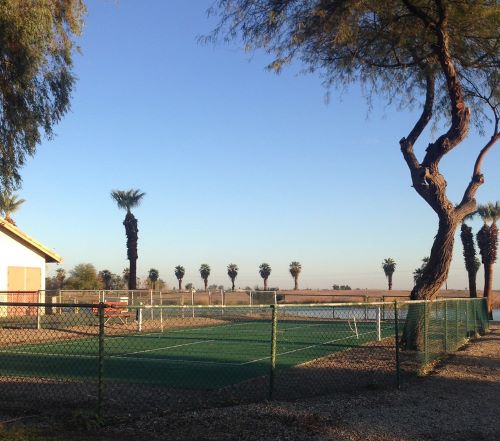
-
Asphalt and Concrete
There’s nothing stopping you from playing pickleball on bare asphalt and concrete, but it’s the worst court surface you can play on. Concrete and asphalt are incredibly dense and even rough. They do not absorb energy at all compared to other court surfaces.
This means that all your force and energy are being reflected back to your joints, specifically your knees, and ankles. Not only is this painful for your feet, but it’s also incredibly bad for your joint health.
Cons of playing on bare asphalt or concrete:
- Slippery, especially when wet from sweat or rain
- The rough bare surface chews quicker through pickleball
- If the surface is polished, it can be very slippery even when not wet
- The surface is often irregular, and even if smoothed out properly, will still expand and contract in response to the temperature of the sun
- Bare concrete is a bad shock absorber and will make the pickleball extra loud
Outside of just playing, bare concrete and asphalt degrade faster without a surface coating. And the maintenance for these is much more expensive than maintaining a surface coat.
So, not only is playing on concrete and asphalt bad for your body, their rough surface eats through your pickleball quicker and can cause inconsistent bouncing.
Special Pickleball Court Surface?
-
Grass
You cannot play pickleball on grass. Period. The pickleball simply can’t bounce enough like it does on a hard surface. However, there are tons of people who play a slightly modified version of pickleball on grass and make it work.
The only time you can use grass as a pickleball court surface is if you play no-bounce pickleball. This is when you make the net taller, like in badminton, and then play pickleball with only volleys. The pickleball can’t touch the ground, because—well—it doesn’t bounce. If you’re fine with playing pickleball that way, then you can definitely use your lawn or some other grass field as a playing surface. Just remember what to expect:
Grass courts require constant maintenance to maintain a level surface, and even then, the surface may not be consistent enough for competitive play. Now, there are different types of grass surfaces that can be used for pickleball, including natural, turf, and plastic. But these are usually more expensive than plexiflor, acrylotex, and polyurethane surfaces.
| Pros | Cons |
|---|---|
| Provides a softer surface compared to asphalt or concrete | Requires constant maintenance to maintain a level playing surface |
| Great cushioning for joints and preventing injury | Almost impossible to manually dry when wet |
| Is aesthetically pleasing | You can’t play “real” pickleball on it, you can only play a modified, no-bounce version |
| Cheap if you already have a lawn that just needs to be flattened and mowed down |
| Price: | Maintenance: |
|---|---|
| The cost of a grass court can vary significantly depending on the size and scope of the project. Generally, it is cheaper than other court surface materials, but the more frequent and ongoing maintenance costs will eventually add up. | Overall, maintaining a grass court can be time-consuming and expensive. You will need to mow and water the grass regularly, not to mention aerate and fertilize the soil, and pluck out unwanted weeds. |
Is There a Difference Between Indoor and Outdoor Pickleball Court Surfaces?
Not really. All the surface coatings for pickleball courts have some form of weather- and heat resistance, so they work both indoors and outdoors. The main difference is the quality and kind of coating. But generally speaking, both courts should have a base layer and coating on top.
Cost of Installing Pickleball Surface Coats
The cost of installing pickleball surface coats on top of base layers like concrete and asphalt can vary widely depending on several factors such as the type of surface coat, the size of the court, and the condition of the base layer.
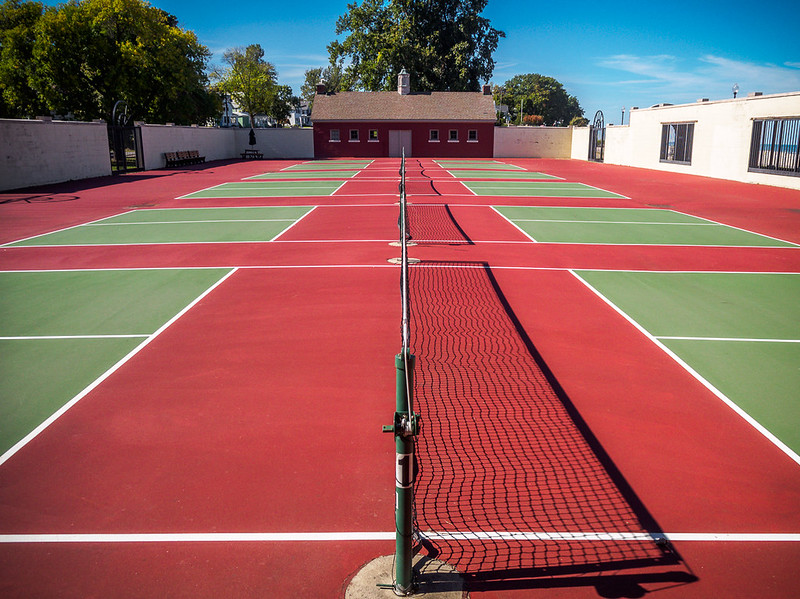
Generally speaking, the cost can range from around $4 to $8 per square foot, but it can go up to $10 to $12 per square foot for premium surfaces. This cost includes the material, installation, and labor costs.
It’s important to note that additional costs may also be incurred for site preparation, leveling, and repair of the base layer if necessary. Maintenance costs may also vary depending on the type of surface coat used and the frequency of maintenance required.
Maintenance cost of having pickleball surface coats?
Here is an approximate breakdown of the maintenance costs for a pickleball court:
Cleaning
Regular cleaning is essential to keep the court in good condition. Depending on the size of the court and the frequency of use, cleaning will set you back around $50 to $150 per session.
Resurfacing
Over time, the surface of a court will wear down and require resurfacing. The frequency of resurfacing depends on the type of surface material used and the intensity of use. The cost can range from $1.50 to $3.50 per square foot.
Repainting
Like the surface, paint on the court lines and markings will fade over time. The cost of repainting varies based on the size of the court and the number of lines, but typically ranges from $100 to $500.
Crack Repair
Cracks on the surface of a court can lead to further damage if left untreated. Repairing cracks can cost between $100 to $500, depending on the size and number of cracks.
Replacement
Eventually, the surface of a court will wear down to the point where it will need to be replaced. The cost of replacing a court surface will depend on the size of the court and the type of surface material used.
Overall, the cost of maintenance for a pickleball court can range from a few hundred to a few thousand dollars per year, depending on the factors outlined above. Regular maintenance is essential for maximizing the lifespan of the court and ensuring a safe and enjoyable playing experience for all players.